Wetroom Shower Screens
Wetroom shower screens have become increasingly popular in modern bathroom design, offering a sleek and practical solution for those seeking to create a stylish and functional bathing space. These versatile fixtures have transformed the way we think about bathroom layouts, blurring the lines between traditional shower enclosures and open-plan wetrooms.
Abacus Elements 2000 x 290mm Fixed Wetroom Screen (8mm) with Ceiling Support & Polished Recessed Channel
Now Only £183.75
Abacus Elements 2000 x 290mm Fixed Wetroom Screen (8mm) with Inline Support & Polished Recessed Channel
Now Only £183.75
Abacus Elements 2000 x 290mm Fixed Wetroom Screen (8mm) with Ceiling Support & Polished Surface Channel
Now Only £183.75
Abacus Elements 2000 x 290mm Fixed Wetroom Screen (8mm) with Inline Support & Polished Surface Channel
Now Only £183.75
Abacus Elements 2000 x 290mm Fixed Wetroom Screen (8mm) with Ceiling Support & Brushed Nickel Recessed Channel
Now Only £187.95
Abacus Elements 2000 x 290mm Fixed Wetroom Screen (8mm) with Inline Support & Brushed Nickel Recessed Channel
Now Only £187.95
Abacus Elements 2000 x 290mm Fixed Wetroom Screen (8mm) with Ceiling Support & Matt Black Recessed Channel
Now Only £187.95
Abacus Elements 2000 x 290mm Fixed Wetroom Screen (8mm) with Inline Support & Matt Black Recessed Channel
Now Only £187.95
Abacus Elements 2000 x 290mm Fixed Wetroom Screen (8mm) with Ceiling Support & Brushed Nickel Surface Channel
Now Only £187.95
Abacus Elements 2000 x 290mm Fixed Wetroom Screen (8mm) with Inline Support & Brushed Nickel Surface Channel
Now Only £187.95
Abacus Elements 2000 x 290mm Fixed Wetroom Screen (8mm) with Ceiling Support & Matt Black Surface Channel
Now Only £187.95
Abacus Elements 2000 x 290mm Fixed Wetroom Screen (8mm) with Inline Support & Matt Black Surface Channel
Now Only £187.95
Abacus Elements 2000 x 290mm Fixed Wetroom Screen (8mm) with Wall Support & Polished Recessed Channel
Now Only £190.05
Abacus Elements 2000 x 290mm Fixed Wetroom Screen (8mm) with Ceiling Support & Matt Grey Recessed Channel
Now Only £190.05
Abacus Elements 2000 x 290mm Fixed Wetroom Screen (8mm) with Inline Support & Matt Grey Recessed Channel
Now Only £190.05
Abacus Elements 2000 x 290mm Fixed Wetroom Screen (8mm) with Wall Support & Polished Surface Channel
Now Only £190.05
Abacus Elements 2000 x 290mm Fixed Wetroom Screen (8mm) with Ceiling Support & Brushed Bronze Surface Channel
Now Only £190.05
Abacus Elements 2000 x 290mm Fixed Wetroom Screen (8mm) with Inline Support & Brushed Bronze Surface Channel
Now Only £190.05
Abacus Elements 290mm Fixed Wetroom Screen (8mm) with Ceiling Support & Brushed Brass Surface Channel
Now Only £190.05
Abacus Elements 290mm Fixed Wetroom Screen (8mm) with Inline Support & Brushed Brass Surface Channel
Now Only £190.05
Abacus Elements 2000 x 290mm Fixed Wetroom Screen (8mm) with Ceiling Support & Matt Grey Surface Channel
Now Only £190.05
Abacus Elements 2000 x 290mm Fixed Wetroom Screen (8mm) with Inline Support & Matt Grey Surface Channel
Now Only £190.05
Abacus Elements 2000 x 290mm Fixed Wetroom Screen (8mm) with Ceiling Support & Polished Minimal Channel
Now Only £193.20
Abacus Elements 2000 x 290mm Fixed Wetroom Screen (8mm) with Inline Support & Polished Minimal Channel
Now Only £193.20
Abacus Elements 2000 x 290mm Fixed Wetroom Screen (10mm) with Ceiling Support & Polished Recessed Channel
Now Only £193.20
Abacus Elements 2000 x 290mm Fixed Wetroom Screen (10mm) with Inline Support & Polished Recessed Channel
Now Only £193.20
Abacus Elements 2000 x 290mm Fixed Wetroom Screen (10mm) with Ceiling Support & Polished Surface Channel
Now Only £193.20
Abacus Elements 2000 x 290mm Fixed Wetroom Screen (10mm) with Inline Support & Polished Surface Channel
Now Only £193.20
Abacus Elements 2000 x 290mm Fixed Wetroom Screen (8mm) with Wall Support & Brushed Nickel Recessed Channel
Now Only £196.35
Abacus Elements 2000 x 290mm Fixed Wetroom Screen (8mm) with Wall Support & Matt Black Recessed Channel
Now Only £196.35
Abacus Elements 2000 x 290mm Fixed Wetroom Screen (8mm) with Wall Support & Brushed Nickel Surface Channel
Now Only £196.35
Abacus Elements 2000 x 290mm Fixed Wetroom Screen (8mm) with Wall Support & Matt Black Surface Channel
Now Only £196.35
Abacus Elements 2000 x 290mm Fixed Wetroom Screen (8mm) with Ceiling Support & Brushed Nickel Minimal Channel
Now Only £197.40
Abacus Elements 2000 x 290mm Fixed Wetroom Screen (8mm) with Inline Support & Brushed Nickel Minimal Channel
Now Only £197.40
Abacus Elements 2000 x 290mm Fixed Wetroom Screen (8mm) with Ceiling Support & Matt Black Minimal Channel
Now Only £197.40
Abacus Elements 2000 x 290mm Fixed Wetroom Screen (8mm) with Inline Support & Matt Black Minimal Channel
Now Only £197.40
Abacus Elements 2000 x 290mm Fixed Wetroom Screen (10mm) with Ceiling Support & Brushed Nickel Recessed Channel
Now Only £197.40
Abacus Elements 2000 x 290mm Fixed Wetroom Screen (10mm) with Inline Support & Brushed Nickel Recessed Channel
Now Only £197.40
Abacus Elements 2000 x 290mm Fixed Wetroom Screen (10mm) with Ceiling Support & Matt Black Recessed Channel
Now Only £197.40
Abacus Elements 2000 x 290mm Fixed Wetroom Screen (10mm) with Inline Support & Matt Black Recessed Channel
Now Only £197.40
Abacus Elements 2000 x 290mm Fixed Wetroom Screen (10mm) with Ceiling Support & Brushed Nickel Surface Channel
Now Only £197.40
Abacus Elements 2000 x 290mm Fixed Wetroom Screen (10mm) with Inline Support & Brushed Nickel Surface Channel
Now Only £197.40
Abacus Elements 2000 x 290mm Fixed Wetroom Screen (10mm) with Ceiling Support & Matt Black Surface Channel
Now Only £197.40
Abacus Elements 2000 x 290mm Fixed Wetroom Screen (10mm) with Inline Support & Matt Black Surface Channel
Now Only £197.40
Abacus Elements 2000 x 290mm Fixed Wetroom Screen (8mm) with Wall Support & Polished Minimal Channel
Now Only £199.50
Abacus Elements 2000 x 290mm Fixed Wetroom Screen (8mm) with Ceiling Support & Brushed Bronze Minimal Channel
Now Only £199.50
Abacus Elements 2000 x 290mm Fixed Wetroom Screen (8mm) with Inline Support & Brushed Bronze Minimal Channel
Now Only £199.50
Abacus Elements 2000 x 290mm Fixed Wetroom Screen (8mm) with Ceiling Support & Matt Grey Minimal Channel
Now Only £199.50
Abacus Elements 2000 x 290mm Fixed Wetroom Screen (8mm) with Inline Support & Matt Grey Minimal Channel
Now Only £199.50
Abacus Elements 2000 x 290mm Fixed Wetroom Screen (10mm) with Wall Support & Polished Recessed Channel
Now Only £199.50
Abacus Elements 2000 x 290mm Fixed Wetroom Screen (10mm) with Ceiling Support & Matt Grey Recessed Channel
Now Only £199.50
Abacus Elements 2000 x 290mm Fixed Wetroom Screen (10mm) with Inline Support & Matt Grey Recessed Channel
Now Only £199.50
Abacus Elements 2000 x 290mm Fixed Wetroom Screen (10mm) with Wall Support & Polished Surface Channel
Now Only £199.50
Abacus Elements 2000 x 290mm Fixed Wetroom Screen (10mm) with Ceiling Support & Brushed Bronze Surface Channel
Now Only £199.50
Abacus Elements 2000 x 290mm Fixed Wetroom Screen (10mm) with Inline Support & Brushed Bronze Surface Channel
Now Only £199.50
Abacus Elements 290mm Fixed Wetroom Screen (10mm) with Ceiling Support & Brushed Brass Surface Channel
Now Only £199.50
Abacus Elements 290mm Fixed Wetroom Screen (10mm) with Inline Support & Brushed Brass Surface Channel
Now Only £199.50
Abacus Elements 2000 x 290mm Fixed Wetroom Screen (10mm) with Ceiling Support & Matt Grey Surface Channel
Now Only £199.50
Abacus Elements 2000 x 290mm Fixed Wetroom Screen (10mm) with Inline Support & Matt Grey Surface Channel
Now Only £199.50
Abacus Elements 2000 x 290mm Fixed Wetroom Screen (8mm) with Wall Support & Matt Grey Recessed Channel
Now Only £200.55
Abacus Elements 2000 x 290mm Fixed Wetroom Screen (8mm) with Wall Support & Brushed Bronze Surface Channel
Now Only £200.55
Abacus Elements 290mm Fixed Wetroom Screen (8mm) with Wall Support & Brushed Brass Surface Channel
Now Only £200.55
Abacus Elements 2000 x 290mm Fixed Wetroom Screen (8mm) with Wall Support & Matt Grey Surface Channel
Now Only £200.55
Abacus Elements 2000 x 290mm Fixed Wetroom Screen (10mm) with Ceiling Support & Polished Minimal Channel
Now Only £201.60
Abacus Elements 2000 x 290mm Fixed Wetroom Screen (10mm) with Inline Support & Polished Minimal Channel
Now Only £201.60
Abacus Elements 2000 x 390mm Fixed Wetroom Screen (8mm) with Ceiling Support & Polished Recessed Channel
Now Only £204.75
Abacus Elements 2000 x 390mm Fixed Wetroom Screen (8mm) with Inline Support & Polished Recessed Channel
Now Only £204.75
Abacus Elements 2000 x 390mm Fixed Wetroom Screen (8mm) with Ceiling Support & Polished Surface Channel
Now Only £204.75
Abacus Elements 2000 x 390mm Fixed Wetroom Screen (8mm) with Inline Support & Polished Surface Channel
Now Only £204.75
Abacus Elements 2000 x 290mm Fixed Wetroom Screen (8mm) with Wall Support & Brushed Nickel Minimal Channel
Now Only £205.80
Abacus Elements 2000 x 290mm Fixed Wetroom Screen (10mm) with Ceiling Support & Brushed Nickel Minimal Channel
Now Only £205.80
Abacus Elements 2000 x 290mm Fixed Wetroom Screen (10mm) with Inline Support & Brushed Nickel Minimal Channel
Now Only £205.80
Abacus Elements 2000 x 290mm Fixed Wetroom Screen (8mm) with Wall Support & Matt Black Minimal Channel
Now Only £205.80
Abacus Elements 2000 x 290mm Fixed Wetroom Screen (10mm) with Ceiling Support & Matt Black Minimal Channel
Now Only £205.80
Abacus Elements 2000 x 290mm Fixed Wetroom Screen (10mm) with Inline Support & Matt Black Minimal Channel
Now Only £205.80
Abacus Elements 2000 x 290mm Fixed Wetroom Screen (10mm) with Wall Support & Brushed Nickel Recessed Channel
Now Only £205.80
Abacus Elements 2000 x 290mm Fixed Wetroom Screen (10mm) with Wall Support & Matt Black Recessed Channel
Now Only £205.80
Abacus Elements 2000 x 290mm Fixed Wetroom Screen (10mm) with Wall Support & Brushed Nickel Surface Channel
Now Only £205.80
Abacus Elements 2000 x 290mm Fixed Wetroom Screen (10mm) with Wall Support & Matt Black Surface Channel
Now Only £205.80
Abacus Elements 2000 x 290mm Fixed Wetroom Screen (10mm) with Wall Support & Polished Minimal Channel
Now Only £207.90
Abacus Elements 2000 x 290mm Fixed Wetroom Screen (10mm) with Ceiling Support & Brushed Bronze Minimal Channel
Now Only £207.90
Abacus Elements 2000 x 290mm Fixed Wetroom Screen (10mm) with Inline Support & Brushed Bronze Minimal Channel
Now Only £207.90
Abacus Elements 2000 x 290mm Fixed Wetroom Screen (10mm) with Ceiling Support & Matt Grey Minimal Channel
Now Only £207.90
Abacus Elements 2000 x 290mm Fixed Wetroom Screen (10mm) with Inline Support & Matt Grey Minimal Channel
Now Only £207.90
Abacus Elements 2000 x 390mm Fixed Wetroom Screen (8mm) with Ceiling Support & Brushed Nickel Recessed Channel
Now Only £208.95
Abacus Elements 2000 x 390mm Fixed Wetroom Screen (8mm) with Inline Support & Brushed Nickel Recessed Channel
Now Only £208.95
Abacus Elements 2000 x 390mm Fixed Wetroom Screen (8mm) with Ceiling Support & Matt Black Recessed Channel
Now Only £208.95
Abacus Elements 2000 x 390mm Fixed Wetroom Screen (8mm) with Inline Support & Matt Black Recessed Channel
Now Only £208.95
In essence, wetroom shower screens are glass panels that separate the shower area from the rest of the bathroom, eliminating the need for a full enclosure or raised shower tray. They've gained traction in recent years due to their minimalist aesthetic and ability to maximise space in bathrooms of all sizes. From compact city flats to sprawling country homes, wetroom shower screens are making waves in the world of interior design.

The rise of wetroom shower screens can be traced back to the growing desire for more open, accessible bathroom spaces. As homeowners and designers alike sought ways to create bathrooms that felt larger and more luxurious, the concept of the wetroom began to take hold. Wetroom shower screens played a crucial role in this evolution, offering a practical way to contain water splashes while maintaining an open feel.
Today, wetroom shower screens are more than just a practical necessity; they're a design statement in their own right. They come in a variety of styles, from frameless panels that seem to float in space to partially framed options that add a touch of industrial chic. Whether you're renovating an existing bathroom or designing a new one from scratch, understanding the ins and outs of wetroom shower screens is essential for creating a space that's both beautiful and functional.
Understanding Wetroom Shower Screens
To truly appreciate the impact of wetroom shower screens, it's important to understand what they are and how they differ from traditional shower enclosures. At their core, wetroom shower screens are glass panels designed to partially enclose a shower area within a bathroom that's been waterproofed to function as a wetroom. Unlike full shower enclosures, these screens don't create a sealed space but rather act as a stylish barrier to contain water splashes.
The key difference between wetroom shower screens and traditional shower enclosures lies in their design and installation. Traditional enclosures typically require a raised shower tray and a full set of panels or doors to create a sealed unit. In contrast, wetroom shower screens are installed directly onto a level floor that slopes gently towards a drain. This creates a seamless transition between the shower area and the rest of the bathroom, eliminating the need to step over a threshold.
The benefits of wetroom shower screens are numerous and varied. From an aesthetic standpoint, they contribute to a clean, minimalist look that can make even the smallest bathroom feel more spacious. The absence of a bulky enclosure or shower tray creates an uninterrupted visual flow, enhancing the sense of openness in the room. This can be particularly beneficial in compact bathrooms, where every inch counts.
Beyond their visual appeal, wetroom shower screens offer practical advantages too. They're incredibly simple to clean, with fewer nooks and crannies where soap scum and mildew can accumulate. The lack of a shower tray also means there's one less place for water to pool, reducing the risk of leaks and water damage over time.
Accessibility is another significant benefit of wetroom shower screens. The level-access design makes them ideal for users with mobility issues, as there's no step to navigate when entering or exiting the shower area. This makes wetroom shower screens an excellent choice for those planning to age in place or for households with family members who have mobility challenges.
Lastly, wetroom shower screens offer unparalleled flexibility in terms of bathroom layout. They can be installed in corners, along walls, or even as freestanding dividers in larger spaces. This versatility allows for creative bathroom designs that might not be possible with traditional shower enclosures, opening up a world of possibilities for homeowners and designers alike.

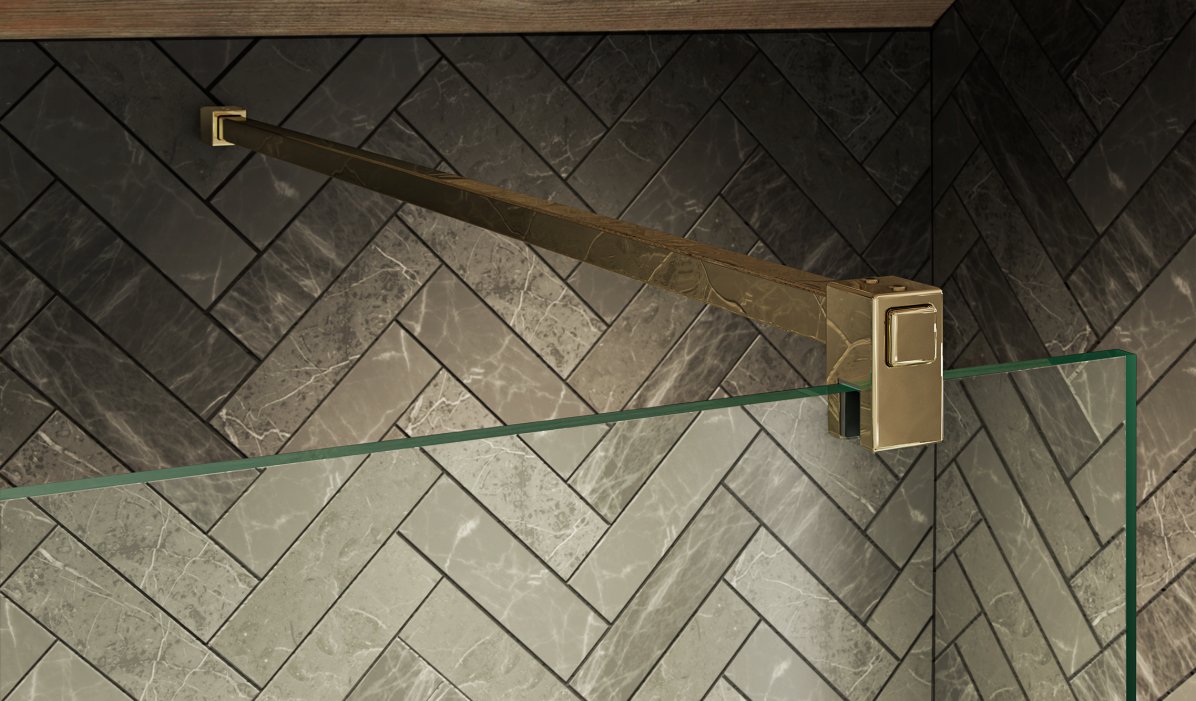
Types of Wetroom Shower Screens
When it comes to wetroom shower screens, there's no one-size-fits-all solution. The market offers a variety of options to suit different bathroom layouts, personal preferences, and budgetary constraints. Understanding the different types available can help you make an informed decision when choosing the right screen for your space.
Fixed panels are perhaps the most common type of wetroom shower screen. As the name suggests, these are stationary glass panels that are securely fastened to the wall and/or floor. They're an excellent choice for those who prefer a minimalist look, as they offer clean lines and unobstructed views. Fixed panels come in various sizes and can be customised to fit specific dimensions, making them suitable for both small and large bathrooms. They're particularly effective in walk-in shower designs where a single panel is sufficient to contain water splashes.
Hinged screens, also known as pivot screens, offer a bit more flexibility. These screens are attached to the wall with hinges, allowing them to swing open and close. This can be particularly useful in smaller bathrooms, where you might need to create more space when the shower isn't in use. Cleaning hinged screens is easier because you can swing them out to access all shower areas. However, it's worth noting that they do require enough clearance space to open fully, which might not be feasible in very compact bathrooms.
Sliding screens provide another solution, especially for bathrooms where space is at a premium. These screens consist of two or more panels that slide along a track, similar to sliding patio doors. They're an excellent option if you want the flexibility to fully enclose your shower area without sacrificing floor space. Sliding screens can create a more traditional shower enclosure feel while still maintaining the wetroom aesthetic.
When considering wetroom shower screens, you'll also need to decide between frameless and framed options. Frameless screens are made entirely of glass, with minimal hardware visible. They offer a sleek, modern look that's particularly popular in contemporary bathroom designs. Frameless screens can make a bathroom feel more spacious and are often easier to clean, as there are fewer places for soap scum and grime to accumulate.
Framed screens, on the other hand, feature a visible frame around the glass panels. While they may not have the same minimalist appeal as frameless options, framed screens can be more budget-friendly and often provide additional stability. They're available in various finishes, from chrome to matte black, allowing you to coordinate with your bathroom's fixtures and fittings.
Materials Used in Wetroom Shower Screens
When it comes to wetroom shower screens, the choice of materials plays a crucial role in both aesthetics and functionality. The two main components to consider are the glass panel itself and, if applicable, the frame or hardware.
Glass is, unsurprisingly, the star of the show in wetroom shower screens. The most common type used is tempered glass, which is heat-treated to increase its strength and safety. If tempered glass breaks, it shatters into small, relatively harmless pieces rather than large, dangerous shards. This makes it an ideal choice for bathroom applications where safety is paramount.
Tempered glass for wetroom shower screens typically ranges from 6mm to 10mm in thickness. The thicker the glass, the more robust and luxurious the screen will feel. However, thicker glass also means a heavier screen, which may require additional support during installation.
Some manufacturers offer laminated glass as an alternative. This consists of two or more sheets of glass bonded together with a layer of polyvinyl butyral (PVB) between them. If broken, laminated glass holds together, offering an extra level of safety. It's worth noting, though, that laminated glass is generally more expensive than tempered glass.
For those seeking a bit more privacy, frosted or textured glass options are available. These can range from a light, subtle frosting to more elaborate patterns or textures. While these options can add visual interest and privacy, they may require more meticulous cleaning to prevent soap scum buildup in the textured areas.
When it comes to frames and hardware, stainless steel is a popular choice due to its durability and resistance to corrosion. It's particularly well-suited to the humid environment of a bathroom. Brushed or polished finishes are available, allowing you to match your screen to other bathroom fixtures.
Aluminium is another common frame material, prized for its lightweight nature and resistance to rust. It can be anodised or powder-coated in a variety of colours, offering more flexibility in terms of aesthetics.
For a more luxurious look, some manufacturers offer brass or copper hardware options. These can develop a beautiful patina over time, adding character to your bathroom. However, they may require more maintenance to keep them looking their best.
When choosing materials for your wetroom shower screen, consider not only the initial appearance but also the long-term durability and maintenance requirements. High-quality materials may cost more upfront but can offer better value in the long run through increased longevity and easier upkeep.


Design Considerations for Wetroom Shower Screens
Designing a bathroom with a wetroom shower screen requires careful consideration of several factors to ensure both functionality and aesthetic appeal. The first and perhaps most crucial aspect is sizing and measurements. Unlike pre-fabricated shower enclosures, wetroom shower screens often need to be custom-sized to fit your specific bathroom layout.
When measuring for your wetroom shower screen, it's essential to consider not just the available space but also the 'splash zone' of your shower. The screen should be large enough to contain water spray effectively. As a general rule, a minimum width of 800mm is recommended for a fixed panel, but this can vary depending on the size and power of your shower head.
Height is another important factor. Standard heights for wetroom shower screens range from 1900mm to 2100mm, but taller options are available for rooms with high ceilings. Remember to account for any slopes or irregularities in your ceiling when taking measurements.
The placement of your wetroom shower screen within the bathroom is another critical design consideration. Ideally, the screen should be positioned to create a natural flow in the room while effectively separating the wet and dry areas. Consider the location of other bathroom fixtures, such as the toilet or vanity, and ensure there's enough clearance for comfortable movement around the space.
Compatibility with existing bathroom fixtures is also crucial. Your wetroom shower screen should complement rather than clash with your overall bathroom design. Consider the style of your taps, shower head, and other fittings when choosing the design of your screen. For instance, a sleek, frameless screen might pair well with modern, minimalist fixtures, while a framed screen could complement more traditional bathroom styles.
Customisation options can add a personal touch to your wetroom shower screen. Many manufacturers offer etched or patterned glass designs, which can range from simple frosted stripes to elaborate decorative patterns. These can add visual interest and a degree of privacy without compromising on light transmission.
Some homeowners opt for tinted glass to add a subtle colour to their bathroom. Green or blue tints can create a spa-like atmosphere, while bronze or grey tints can add a touch of sophistication. However, it's worth noting that tinted glass may slightly reduce the amount of light in your shower area.
Finally, don't forget about practical elements like towel bars or shelves. Some wetroom shower screens can be fitted with these accessories, adding functionality without cluttering your bathroom space. However, be sure to consider how these additions might affect the overall look and maintenance of your screen.
Installation Process
Installing a wetroom shower screen is a task that requires precision and expertise. While it's possible for skilled DIY enthusiasts to tackle the job, many homeowners prefer to leave it to the professionals to ensure a watertight finish.
The first step in the installation process is preparing the bathroom for a wetroom shower screen. This involves ensuring that the entire room, or at least the shower area, is properly waterproofed. This typically includes applying a waterproof membrane to the floors and walls, paying particular attention to corners and joints where water is most likely to penetrate.
The floor must be carefully sloped towards the drain to ensure proper water drainage. This slope, known as the 'fall', is typically around 1:80 to 1:100, meaning the floor drops by 1cm for every 80-100cm towards the drain. Getting this right is crucial for preventing water from pooling or escaping beyond the shower area.
Once the waterproofing and floor preparation are complete, the actual installation of the shower screen can begin. For a fixed panel, this typically involves securing a channel to the floor and/or wall using strong adhesive and screws. The glass panel is then inserted into this channel and secured with silicone sealant.
For hinged or sliding screens, the process is slightly more complex. Hinged screens require the installation of sturdy hinges that can support the weight of the glass panel. Sliding screens need a properly aligned track system to ensure smooth operation.
Professional installation often includes a site survey prior to the installation day. This allows the installer to take precise measurements and identify any potential issues before the screen is manufactured. On the day of installation, professionals will have the necessary tools and expertise to handle the heavy glass panels safely and secure them properly.
While DIY installation is possible, it's not without its challenges. Handling large, heavy pieces of glass can be dangerous without proper equipment and experience. Additionally, any mistakes in the installation could lead to leaks, which can cause significant damage to your bathroom and the structure of your home.
Common installation challenges include dealing with uneven walls or floors, working around existing fixtures, and ensuring a watertight seal around the screen. Professional installers have the experience to overcome these challenges and can often provide warranties on their work, offering peace of mind.
Regardless of whether you choose professional or DIY installation, it's crucial to follow the manufacturer's instructions carefully. This includes using the correct type of silicone sealant and allowing adequate curing time before using the shower.
Cost Analysis
When considering wetroom shower screens, understanding the cost implications is crucial for making an informed decision. The price of wetroom shower screens can vary significantly based on a variety of factors, including size, material quality, design complexity, and brand reputation.
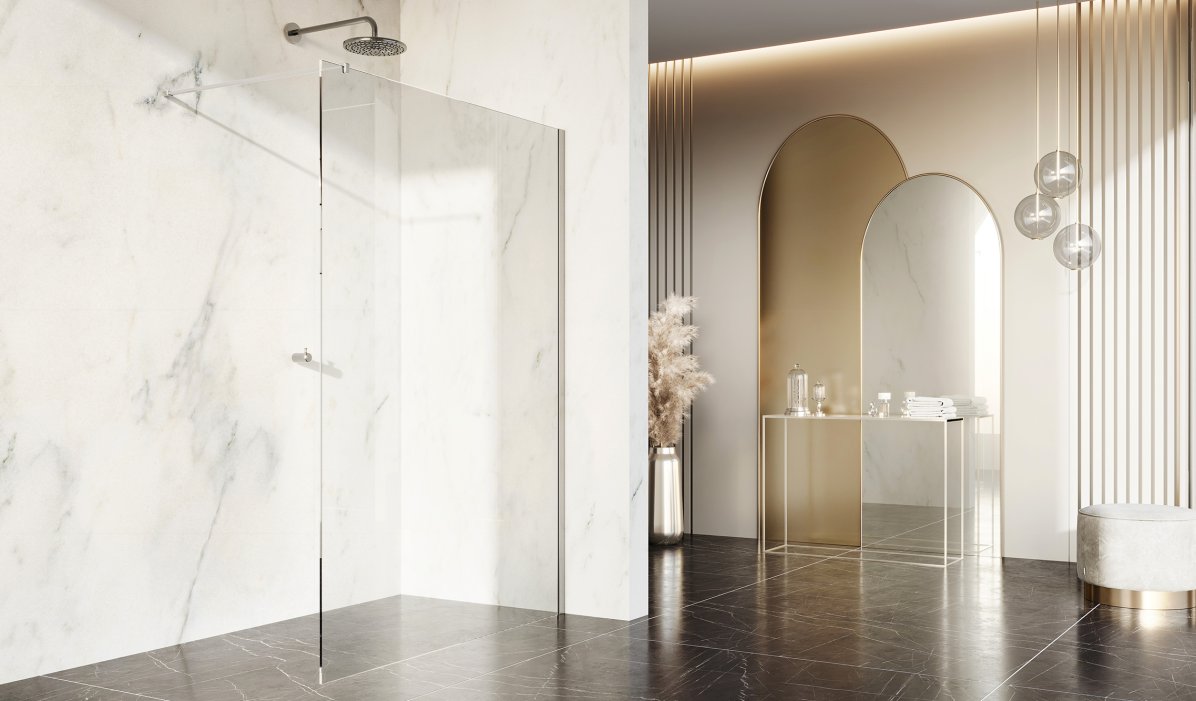
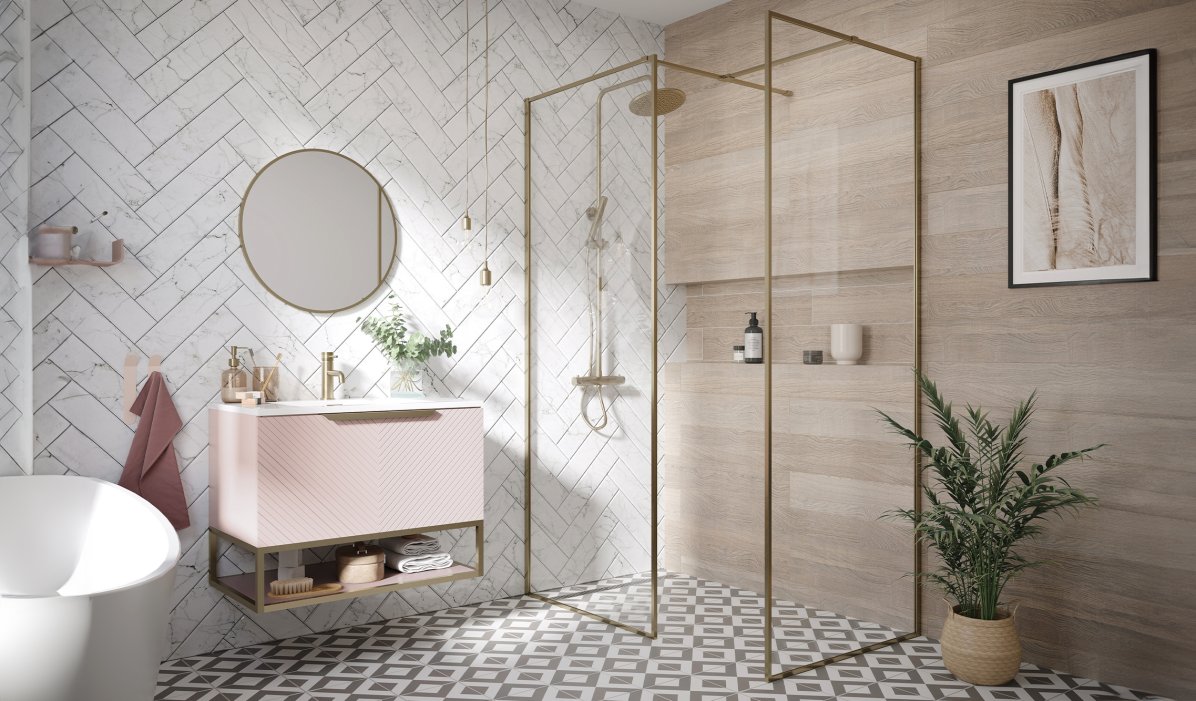
At the lower end of the spectrum, you might find basic fixed panels starting from around £200 to £300. These are typically made of 6mm tempered glass with simple fittings. Mid-range options, which might include 8mm glass, more robust hardware, or simple sliding or hinged designs, can range from £400 to £800.
For high-end, bespoke wetroom shower screens, prices can easily exceed £1,000. These might feature 10mm glass, designer hardware, custom sizes, or special glass treatments like easy-clean coatings. It's worth noting that these prices typically don't include installation, which can add another £200 to £500 to the total cost, depending on the complexity of the job.
When comparing the cost of wetroom shower screens to traditional shower enclosures, it's important to consider the bigger picture. While a basic shower enclosure might be cheaper upfront, wetroom shower screens often add more value to your home. They create a more spacious, luxurious feel and can be particularly appealing to potential buyers if you're considering selling in the future.
Additionally, the open design of wetroom shower screens can make your bathroom more accessible, which is an increasingly important factor for many homeowners. This improved accessibility can be seen as an investment in future-proofing your home.
The return on investment for wetroom shower screens can be significant. They're durable, long-lasting, and can significantly enhance the overall look and functionality of your bathroom. While the initial outlay might be higher than a standard shower enclosure, the added value to your property and the improved bathroom experience can make it a worthwhile investment in the long run.
Choosing the Right Wetroom Shower Screen
Selecting the perfect wetroom shower screen for your bathroom involves carefully considering your specific needs, preferences, and constraints. Start by assessing your bathroom layout. Measure the available space and think about how a shower screen would fit into the room. Consider the position of other fixtures and ensure there's enough clearance for comfortable movement.
Your budget will naturally play a significant role in your decision. While it's tempting to go for the cheapest option, remember that quality matters when it comes to bathroom fittings. A well-made shower screen will last longer, perform better, and potentially save you money on repairs or replacements in the long run.
When evaluating different brands and models, look for reputable manufacturers with good customer reviews. Pay attention to the thickness of the glass, the quality of the hardware, and any special features like easy-clean coatings. Don't be swayed by flashy marketing - focus on the practical aspects that will affect your day-to-day use of the shower.
Reading customer reviews and testimonials can provide valuable insights into the real-world performance of different wetroom shower screens. Look for comments about ease of installation, durability, and how well the screen contains water splashes. Be wary of reviews that seem overly positive or negative, and instead look for balanced, detailed feedback.
Consider visiting a bathroom showroom if possible. This will allow you to see and feel the quality of different shower screens in person. You'll be able to test how smoothly hinged or sliding screens operate and get a better sense of how different designs might look in your own bathroom.
Finally, don't forget to think about aftercare and warranty. A good warranty can provide peace of mind, especially for more expensive models. Check what's covered and for how long, and consider whether extended warranties are available if you want extra protection.

FAQs about Wetroom Shower Screens
Q: Are wetroom shower screens suitable for all bathrooms?
A: While wetroom shower screens can work in many bathroom layouts, they're not suitable for every situation. They work best in bathrooms that can be fully waterproofed and where the floor can be properly sloped for drainage. They might not be ideal for bathrooms with wooden floors or in properties where extensive waterproofing isn't feasible.
Q: How long do wetroom shower screens typically last?
A: With proper care and maintenance, a high-quality wetroom shower screen can last 15-20 years or even longer. The longevity depends on factors such as the quality of materials, installation, and how well it's maintained. Regular cleaning and prompt repairs of any chips or cracks can significantly extend its lifespan.
Q: Can I install a wetroom shower screen in an existing bathroom?
A: Yes, it's possible to install a wetroom shower screen in an existing bathroom, but it may require some renovation work. The floor will need to be waterproofed and possibly re-sloped to ensure proper drainage. Walls may also need additional waterproofing. It's often easier to incorporate a wetroom shower screen during a full bathroom renovation.
Q: What's the difference between a wetroom and a walk-in shower?
A: While similar, there are key differences. A wetroom is a fully waterproofed bathroom where the shower area is open to the rest of the room, with the entire floor gently sloped for drainage. A walk-in shower, on the other hand, is typically a larger shower enclosure with a low-profile tray or a slightly raised area for the shower. Wetroom shower screens can be used in both setups, but true wetrooms require more extensive waterproofing.
Q: Are wetroom shower screens safe for children and elderly users?
A: Wetroom shower screens can be very safe for children and elderly users when properly installed. The lack of a step or threshold makes them easily accessible, reducing the risk of trips and falls. However, it's important to ensure the floor has adequate slip resistance when wet. For additional safety, you might consider adding grab bars or using a textured glass for better visibility.

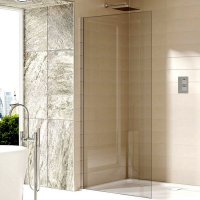

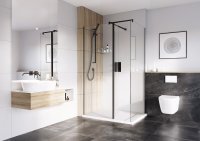

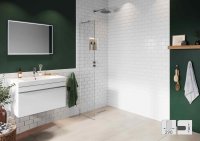



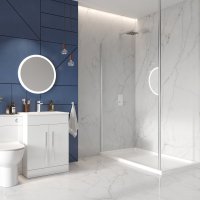












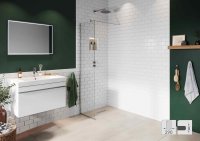






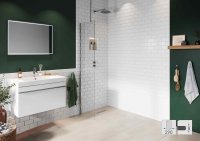
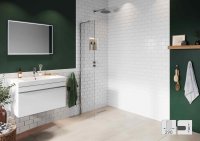




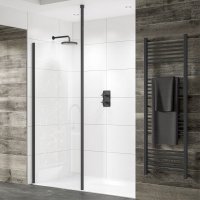
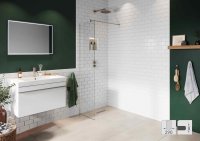
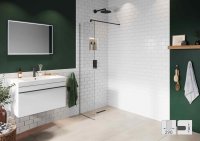
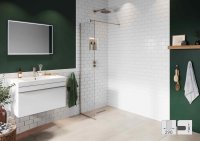


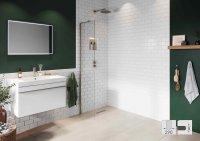


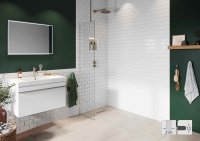







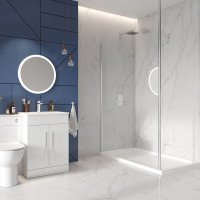









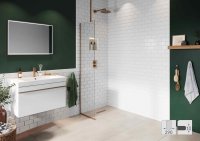
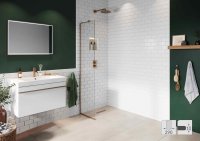


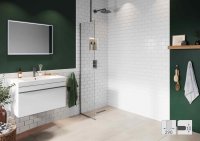

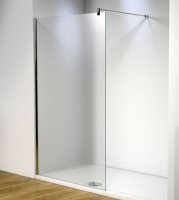
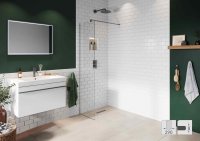
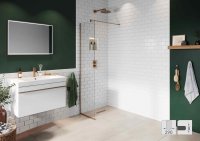


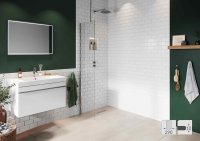



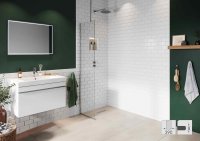
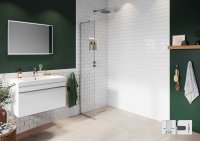



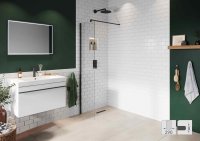
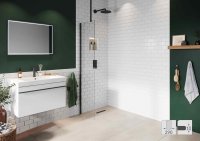
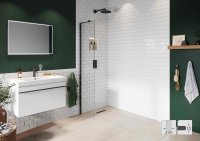




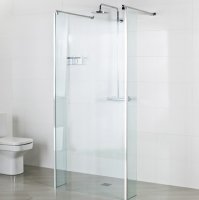

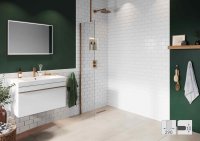

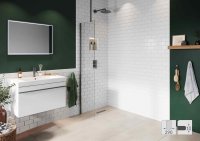

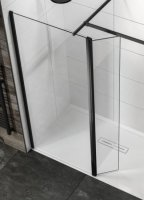


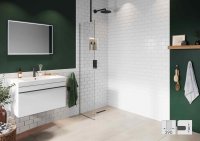







Stay Connected